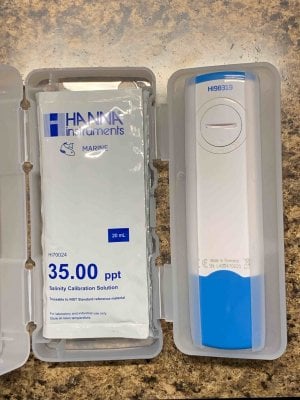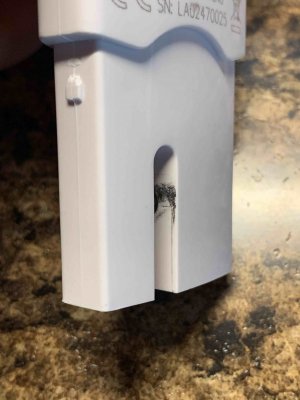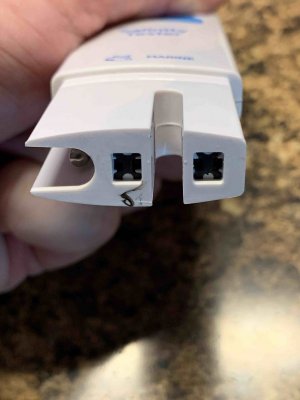Ok - I got back in town and had a nice little present from Marine Depot waiting for me! I've played around with it a bit and I have to say, I'm very impressed.
Like the Hanna checkers, it comes in a nice, sturdy plastic case - it's about the same size as the case for my refractometer.

4 packets of 35 ppt calibration fluid are included. It even has space to store these in the case behind the tester so you don't have random packets floating around with the rest of your fish stuff!

There was a smudge of some dirt on the inside - I read that the tester uses carbon electrodes, so I though it might be some carbon dust from manufacturing, but it didn't rinse off or rub off. Not sure what it is but it didn't seem to affect the accuracy.

Bottom view - you can see the electrodes along with the temperature sensor on the left

Calibration was simple - you rinse the unit in DI water and wipe it off, then turn the unit on, press the calibrate button and place the tester in the packet of fluid. It took about 10-15 seconds or so and that's it. Hanna recommends calibrating about once a month. Marine Depot sells 25 packets for $26 - that should last you for 2 years at $1 per month. Calibrating my refractometer isn't difficult per se - put a few drops of fluid on and adjust the screw as necessary, but I've found that it's very unpredictable when it will drift out of calibration, so I have to calibrate it every time I use it. Plus, refractometers aren't very easy to read (see below.) The Hanna Tester has this beat in spades.
To take a measurement, you dip the end in the water, far enough to submerge the probes, shake a bit to make sure bubbles are removed and wait for the reading to stabilize. It took between 10-12 seconds in my testing. The readings were very repeatable - I took 4 readings in my tank and they were all either 35.0 or 35.1 ppt. Comparing to my vertex refractometer, the readings were dead on. At least I think they were - the consistent problem I have with the refractometer is it's really hard to get more than 0.5 ppt accuracy, and the crispness of the line really depends on the light you use to view. No such problems with the Hanna Tester - LCD displays rock! I don't have a Milwaukee or other digital testers to compare against.
Afterwards, you rinse with some DI water, wipe it dry and you're set.
For the record, I also verified that it floats, just like Hanna says it will - strong work, Hanna!
It's powered by a CR2032 battery and the display gives you the battery percentage on startup. This is a really common battery size, so they're not hard to find, but most of us don't have them laying around, so knowing in advance that the battery is starting to go is quite convenient.
Overall, I'm very impressed and pleased with this tester. In my initial testing it's easy to use, reliable and repeatable. Unless something changes, my trusty refractometer will be gathering a lot of dust. At $70, it's very reasonably priced and I can't see spending $35-40 on a refractometer when you can have this for not that much more. I'll check back with an update when I've had more experience, but kudos to @Hanna Instruments for what seems to be a great product!
Like the Hanna checkers, it comes in a nice, sturdy plastic case - it's about the same size as the case for my refractometer.
4 packets of 35 ppt calibration fluid are included. It even has space to store these in the case behind the tester so you don't have random packets floating around with the rest of your fish stuff!

There was a smudge of some dirt on the inside - I read that the tester uses carbon electrodes, so I though it might be some carbon dust from manufacturing, but it didn't rinse off or rub off. Not sure what it is but it didn't seem to affect the accuracy.

Bottom view - you can see the electrodes along with the temperature sensor on the left

Calibration was simple - you rinse the unit in DI water and wipe it off, then turn the unit on, press the calibrate button and place the tester in the packet of fluid. It took about 10-15 seconds or so and that's it. Hanna recommends calibrating about once a month. Marine Depot sells 25 packets for $26 - that should last you for 2 years at $1 per month. Calibrating my refractometer isn't difficult per se - put a few drops of fluid on and adjust the screw as necessary, but I've found that it's very unpredictable when it will drift out of calibration, so I have to calibrate it every time I use it. Plus, refractometers aren't very easy to read (see below.) The Hanna Tester has this beat in spades.
To take a measurement, you dip the end in the water, far enough to submerge the probes, shake a bit to make sure bubbles are removed and wait for the reading to stabilize. It took between 10-12 seconds in my testing. The readings were very repeatable - I took 4 readings in my tank and they were all either 35.0 or 35.1 ppt. Comparing to my vertex refractometer, the readings were dead on. At least I think they were - the consistent problem I have with the refractometer is it's really hard to get more than 0.5 ppt accuracy, and the crispness of the line really depends on the light you use to view. No such problems with the Hanna Tester - LCD displays rock! I don't have a Milwaukee or other digital testers to compare against.
Afterwards, you rinse with some DI water, wipe it dry and you're set.
For the record, I also verified that it floats, just like Hanna says it will - strong work, Hanna!
It's powered by a CR2032 battery and the display gives you the battery percentage on startup. This is a really common battery size, so they're not hard to find, but most of us don't have them laying around, so knowing in advance that the battery is starting to go is quite convenient.
Overall, I'm very impressed and pleased with this tester. In my initial testing it's easy to use, reliable and repeatable. Unless something changes, my trusty refractometer will be gathering a lot of dust. At $70, it's very reasonably priced and I can't see spending $35-40 on a refractometer when you can have this for not that much more. I'll check back with an update when I've had more experience, but kudos to @Hanna Instruments for what seems to be a great product!




















